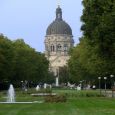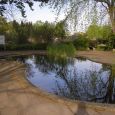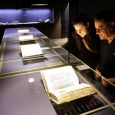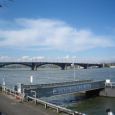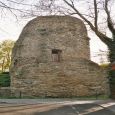Mainz
Advertisement
By Air
Mainz is served by Frankfurt Airport on the North-East Side, the busiest airport by passenger traffic in Germany by far, the third busiest in Europe and the ninth busiest worldwide in 2009 as well as Mainz Finthen Airport, located about 3 miles southwest and Frankfurt-Hahn Airport located about 50 miles west.
By Train
Mainz Hauptbahnhof or Mainz main station, is frequented by 80,000 travelers and visitors each day and is therefore one of the busiest 21 stations in Germany. It is the terminus of Line S8:Wiesbaden Hbf–Mainz Hbf–Russelsheim–Frankfurt Hbf–Hanau Hbf; of the Rhine-Main S-Bahn and it is the start of the Mainbahn to Frankfurt Hbf. It is served by 440 daily local and regional trains (StadtExpress, RE and RB) and 78 long-distance trains (IC, EC and ICE).Intercity-Express lines connect Mainz with Frankfurt (Main), Karlsruhe Hbf, Worms Hauptbahnhof and Koblenz Hauptbahnhof.It is a terminus of the West Rhine Railway and the Mainz–Ludwigshafen railway, as well as the Alzey–Mainz Railway erected by the Hessische Ludwigsbahn in 1871.Access to the East Rhine Railway is provided by the Kaiserbrücke, a railway bridge across the Rhine at the north end of Mainz.
By Ferry
The Port of Mainz, now handling mainly containers, is a sizable industrial area to the north of the city, along the banks of the Rhine. In order to open up space along the city's riverfront for residential development, it has been shifted further northwards in 2010.
By Bicycle
Mainz offers a wide array of bicycle transportation facilities and events, including several miles of on-street bike lanes providing sufficient bike infrastructure.The touristic Rheinradweg (Rhine Cycle Route) is an international cycle route, running from the source to the mouth of the river Rhine, passing four countries at 1,300 km distance.A cycling tour towards Bingen and further to the UNESCO World Heritage Site (2002) Middle Rhine is truly amazing.
Advertisement
Romano-Germanic Central Museum
is an archaeological and historical research institution for pre-history and early history headquartered in Mainz.It is supported by the Federal Republic of Germany and its states and is a member of the Leibniz Association of German research institutions.The Romano-Germanic Central Museum was founded in 1852 by Ludwig Lindenschmit the Elder, after the decision was taken at the 16–19 August Versammlung deutscher Geschichts- und Alterthumsforscher (Assembly of German Researchers in History and Classical Studies) in Dresden that a "central museum for Germanic and Roman artifacts" should be founded in Mainz and a "Germanic museum" should be founded in Nuremberg (the Germanisches Nationalmuseum).It was no accident that the museum was established in the city of Mainz, with its high importance in the Middle Ages, and housed in the Electoral Palace; rather these decisions symbolised the museum's national aspirations in the era of the German Confederation.In early December 2007, the museum announced plans for a new building on the southern edge of Mainz, next to the Museum of Ancient Seafaring which is one of its annexes.
Mainz Cathedral
is located near the historical center and pedestrianized market square of the city of Mainz, Germany.This 1000 year-old Roman Catholic cathedral is the site of the episcopal see of the Bishop of Mainz.Mainz Cathedral is predominantly Romanesque in style, but later exterior additions over many centuries have resulted in the appearance of various architectural influences seen today.It comprises three naves and stands under the patronage of Saint Martin of Tours.The eastern quire is dedicated to Saint Stephen.The interior of the cathedral houses tombs and funerary monuments of former powerful Electoral-prince-archbishops, or Kurfurst-Erzbischofe, of the diocese and contains religious works of art spanning a millennium.The cathedral also has a central courtyard and statues of Saint Boniface and The Madonna on its grounds.
Electoral Palace
is the former city Residenz of the Archbishop of Mainz, who was also Prince-Elector of his electoral state within the Holy Roman Empire.It is one of the important Renaissance buildings in Germany.Originally the Archbishop of Mainz resided at the cathedral, where there is an old private chapel dating from 1137.Today the east wing houses the Museum of Roman and Germanic History. An assortment of replicas and valuable original items presents a comprehensive picture of the cultural life of prehistoric times, of the Roman Empire, and of the early Middle Ages.The north wing contains the famous function hall from which the annual Karneval TV show Mainz bleibt Mainz, wie es singt und lacht is broadcast.The Electoral Palace is now one of eight venues managed by Congress Centrum Mainz.There are seven halls and many smaller rooms, enabling events to be staged for up to 1,700 persons.
Gutenberg Museum
is one of the oldest museums of printing in the world, located opposite the cathedral in the old part of Mainz, Germany. It is named after Johann Gutenberg, the inventor of printing from moveable metal type.The collections include printing equipment and examples of printed materials from many cultures.A group of citizens founded the museum in 1900, 500 years after Johann Gutenberg’s birth, to honour the inventor and present his technical and artistic achievements to the public at large.They also aimed to exhibit the writing and printing of as many different cultures as possible.The museum made several important acquisitions in the following years, among them a second Gutenberg Bible, the Shuckburgh Bible in two volumes (1978), and two block books printed using wooden formes and today extremely rare.Another major change was the introduction of the museum’s educational unit in 1989. In 2000, the old museum building was restored and extended.
St. Stephen's Church
is a Gothic hall collegiate church located in the German city of Mainz.St. Stephan zu Mainz was originally built in 990 at the order of Archbishop Willigis, who also initiated the building of Mainz Cathedral.The church was founded on top of the highest hill in the town, most likely on behalf of Theophanu, the widow of Otto II, Holy Roman Emperor.Willigis intended the church to be a site of prayer for the Empire.The provost of the Collegiate Church administered one of the archdiaconates (a medieval organizational form similar to today's diaconates) of the Archbishopric of Mainz.
Mainz State Museum
is a museum of art and history in Mainz, Germany.In March 2010 it reopened in full after an extensive renovation.The museum has its roots in a painting collection donated by Napoleon and Chaptal to the city of Mainz in 1803.It moved into its current location, in the former electoral stables, in 1937, by which time it had grown significantly.It received its present name in 1986, and was renovated and modernised from 2004 to 2010.Antiquities from the Mainz area, including a Venus-like statue from 23,000 BC; stone axes from the Late Stone Age; Roman stone memorials; busts of bronze and marble; a 1st-century Roman Jupiter Column; a 3rd-century Roman arch.
Bassenheimer Palace
is an historic building in Mainz, western Germany.At present (2009) the large structure is the seat of the Ministry of the Interior and Sports of the federal state of Rhineland-Palatinate.The Bassenheimer Hof was erected in 1750 per the plans of the electoral master builder (Oberbaudirektor) Anselm Franz von Ritter zu Groenesteyn (or Grunstein) on behalf of the prince-elector as a retirement home for his sister the widow, the countess of Bassenheim. It was built near the Osteiner Hof.The architect had been particularly impressed, during his studies in Paris, by the Place Vendome and Hotel de Torcy (Hotel de Beauharnais), with their formal statements and their elegant construction, reflecting the baroque French style.The reconstructed building served as the temporary site of the minister president of the German federal state of Rhineland-Palatinate, before its present use by Rhineland-Palatinate (beginning in 1960).
Botanischer Garten Mainz
is an arboretum and botanical garden maintained by the University of Mainz.It is located on the university campus at Franz von Bentzel-Weg 9, Mainz, Rhineland-Palatinate, Germany, and open daily.The garden was created between 1946-1955 on land formerly used as farmland and a military training ground.Over 3500 individual plant beds were created in those years; in the mid-1950s an alpine garden was added, and in 1986 sections for steppe plants and Mainz regional flora were established.The first greenhouse was built in 1948 with two more added in 1952, which formed the basis for an extensive greenhouse complex.Today the garden contains about 8,500 species.Its major sections include an arboretum (30,000 m2), systematic garden, greenhouses, and alpine garden, with outdoor collections focusing on flowering plants and woody plants of the northern hemisphere temperate zone, and a greenhouse complex containing plants from Mediterranean climates and the Southern Hemisphere as well as tropical and subtropical crops.
February - June
August - November
February - June -> 18(°C) - Winter
August - November -> 23(°C) - Summer
Advertisement

